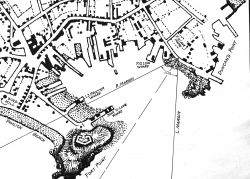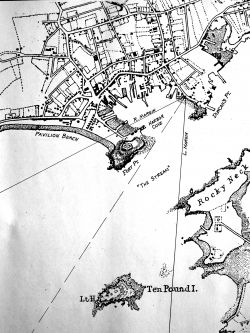loading 
Fitz Henry Lane
HISTORICAL ARCHIVE • CATALOGUE RAISONNÉ • EDUCATIONAL RESOURCE
An online project under the direction of the CAPE ANN MUSEUM
An online project under the direction of the CAPE ANN MUSEUM
Catalog entry
inv. 271
The Fort and Ten Pound Island, Gloucester, Massachusetts
1847 Oil on canvas 20 x 30 in. (50.8 x 76.2 cm) Signed and dated lower right (on beam): F. H. Lane / 1847
Inscribed verso: F H Lane Gloucester / Mass. |
Related Work in the Catalog
Supplementary Images
Provenance (Information known to date; research ongoing.)
the Artist, Gloucester, Mass.
Captain Frederick Gilman Low
Colonel David Low, Gloucester, Mass., 1878
Julia Low Pearce, Gloucester, Mass., 1919
Charles F. Pearce, Gloucester, Mass., c.1948
Kennedy Galleries, New York, 1979
Private collection, until 1981
Hirschl & Adler Galleries, New York
Thyssen-Bornemisza Collection, Lugano, Switzerland, 1982
Thyssen-Bornemisza Museum, Madrid, 1993
Exhibition History
Kennedy Galleries, New York, New York, Selected American Masterworks: John Singleton Copley to Jack Levine, 1770–1979, December 4, 1979–January 5, 1980., no. 4, ill.
Hirschl & Adler Galleries, New York, New York, Lines of Different Character: American Art from 1727 to 1947, November 13, 1982–January 8, 1983., no. 13, ill., p. 27.
Museum of Modern Art, Kobe, Japan, The Rediscovery of Nature: An Anthology of the 19th-Century Landscape Painting in the West, 1983–84., no. T61, ill., pp. 148–49.
International Exhibitions Foundation, Washington, D.C., The Baltimore Museum of Art, Baltimore, Maryland, American Masters: The Thyssen-Bornemisza Collection, September 9–October 28, 1984., no. 19, ill., p. 45.
Traveled to: Detroit Institute of Arts, Detroit, Mich., 19, 1984–20, 1985; IBM Gallery of Science and Art, New York, N.Y., 13–19, 1985; The San Diego Museum of Art, San Diego, Calif., 15, 1985–15, 1986; McNay Art Museum, San Antonio, Tex., 18–15, 1985; Denver Art Museum, Denver, Colo., 23–21, 1985; Society of the Four Arts, Palm Beach, Fla., 14–13, 1986; New Orleans Museum of Art, New Orleans, La., 18–13, 1986.
Traveled to: Detroit Institute of Arts, Detroit, Mich., 19, 1984–20, 1985; IBM Gallery of Science and Art, New York, N.Y., 13–19, 1985; The San Diego Museum of Art, San Diego, Calif., 15, 1985–15, 1986; McNay Art Museum, San Antonio, Tex., 18–15, 1985; Denver Art Museum, Denver, Colo., 23–21, 1985; Society of the Four Arts, Palm Beach, Fla., 14–13, 1986; New Orleans Museum of Art, New Orleans, La., 18–13, 1986.
Palau de la Virreina, Barcelona, Spain, Mestres Americans del Segle XIX de la Col-lecció Thyssen-Bornemisza, 1988., no. 50.
Hyogo Prefectural Museum of Art, Kobe, Japan, Two Hundred Years of American Paintings from the Thyssen-Bornemisza Collection, 1991., no. 5, ill., pp. 60–61.
Museo Thyssen- Bornemisza, Madrid, Spain, Explorar el Eden: Paisaje Americano del siglo XIX, September 29, 2000–January 14, 2001., no. 28, ill., pp. 125–26.
Published References
Wilmerding, John. Fitz Hugh Lane, 1804–1865: American Marine Painter. Salem, MA: The Essex Institute, 1964., no. 124, p. 65, listed as "Undated and Unsigned" (the inscription was concealed by the frame).
Novak, Barbara. Nineteenth-Century American Painting: The Thyssen-Bornemisza Collection. London: Sotheby's Publications, 1986., no. 27, ill., pp. 122–23.
Wilmerding, John. Paintings by Fitz Hugh Lane. Washington, DC: National Gallery of Art; in association with Harry N. Abrams, 1988., p. 24.
Álvarez Lopera, José. Modern Masters: Thyssen-Bornemisza Museum. Madrid: Fundación Colección Thyssen-Bornemisza, 1992., no. 635, ill., pp. 48, 599.
Llorens, Tomàs, María del Mar Borobia, and Concha Vela. Guide to the Thyssen Bornemisza Museum. Madrid: Fundación Colección Thyssen-Bornemisza, 1994., no. 635.
Llorens, Tomas. Explorar el Eden. Paisaje Americano del Siglo XIX. Madrid: Museo Thyssen-Bornemisza, 2000., no. 28, ill., p. 127, text, pp. 125–26.
Alarcó, Paloma. Museo Thyssen-Bornemisza. Pictura Moderna. Madrid: Museo Thyssen-Bornemisza, 2009., p. 59, ill.
Newton, Travers, and Marcia Steele. "The Series Paintings of Fitz Henry Lane: From Field Sketch to Studio Painting." In Emil Bosshard, Paintings Conservator (1945–2006): Essays by Friends and Colleagues, edited by Maria de Peverelli, Mario Grassi, and Hans-Christoph von Imhoff. Florence: Centro Di, 2009, pp. 194–215., fig. 7, p. 204, text, pp. 194–215. ⇒ includes  text
text
Alarcó, Paloma, and M. Borobia. Guía de la colección. Madrid: Museo Thyssen-Bornemisza, 2012., ill., p. 212.
Karl Kusserow. "Fitz Henry Lane's Ship in Fog, Gloucester Harbor." Princeton University Art Museum (Winter 2016)., The Fort and Ten Pound Island, Gloucester, Massachusetts.


Commentary
For his 1847 depiction of Fort Point and Ten Pound Island, Lane chose a slightly higher view point than in his earlier views—further back from the shoreline and closer to the end of Duncan’s Point, whose rocky southern tip is now plainly visible in the left foreground. The tide is lower than in the other two paintings, revealing more of the rocks and beach of the shoreline. This provided Lane with a larger setting for foreground activity that he immediately exploited and which became increasingly busy with succeeding paintings. This painting, and the 1848 version View of Gloucester Harbor, 1848 (inv. 97), show how quickly this process developed.
The warm light of late afternoon creates strong contrasts in the topography of Fort Point and the outlines of Fort Defiance and nearby wharf buildings, also in the ship’s sails and the seaweed covered rocks which stand out from the dark sand around them. The effect is more peaceful than dramatic with puffy fair weather clouds on the horizon, a flat sea, and not enough wind to stir the red pennant at the pinky’s topmast (at right).
Beginning with his early color sketches The Old Fort and Ten Pound Island, Gloucester, 1850s (inv. 28) and /entry291/, Lane’s depictions of Fort Point show little or no change until ca. 1848, when George H. Rogers began a wharf-building project which nearly encircled Fort Point by 1870. In all of Lane’s views Fort Defiance sits atop the point’s summit, its basic form recognizable with much brick and stone work still intact. Not until his 1852 depiction (Inv. 38) do we see advanced signs of its piecemeal demolition by local citizens.
Fort Point is joined to downtown Gloucester by a sandy causeway with Harbor Cove on its north-east-facing side and Pavilion Beach on its southwest side. It was then used as a flake yard for drying fish, with a few wharves jutting from it into Harbor Cove. In this painting’s right background are the wharf and buildings of John W. Lowe, and three fish shacks among the fish flakes (drying racks) in the flake yard. Two fishing schooners lie grounded on the causeway’s intertidal zone.
The rocky beach in the foreground afforded Lane an opportunity to show more human activity with far more narrative than his 1845 treatment of this scene The Old Fort and Ten Pound Island, Gloucester, 1850s (inv. 30). At the end of Duncan’s Point Rocks a man is fishing while a small boy looks on. On the beach in left foreground, a yawl boat is being pushed to the water by six men who are straining at the task. At center at the water’s edge is a wherry, differing in this period from a dory in having a slightly wider stern.
In the right foreground, next to a pile of lumber for building the deck of a cob wharf, a fisherman is dressing some cod while a nattily dressed “Boston dandy” points his walking stick at the catch. Can this dandified Bostonian be one F. H. Lane who, in the year after he painted this picture, moved back to Gloucester?
Only two vessels are afloat and at their moorings in Harbor Cove: a square-stern New England boat and a double-ender called a pinky (whose name is derived from the “pinched” stern – a design feature originated by the Dutch). The New England boat was a direct descendant of the colonial shallop, evolving more in rig (two sails only – no jib) than in hull form.
Outside Harbor Cove, three vessels are in “the Stream”, as the entrance to the Inner Harbor was called. At far left is a lumber brig (technically a hermaphrodite brig or half brig) with a hold full of lumber and a deck load of equal volume, putting her deep in the water.
The ship to the right of Ten Pound Island is very likely in Gloucester’s Surinam Trade, having returned from Paramaribo with a cargo of sugar, molasses, and fine Dutch goods. Her cargo to Surinam was dried salt cod of the lowest grade, intended for feeding the slaves who worked Surinam’s plantations.
The schooner off Fort Point is likely a fisherman; the absence of a fore topmast was common on vessels which fished on offshore banks, particularly Georges Bank. Storms coupled with heavy seas could be violent at any time of year, calling for a simpler sail plan that could be quickly shortened or furled. Gloucester’s fishing industry waned in the second quarter of the 19th century as the Surinam Trade grew and placed greater demands on harbor facilities. Only with the introduction of new fishing gear and methods did this trend reverse itself in the 1850s, while the Surinam trade sought better wharfage in Boston.
–Erik Ronnberg